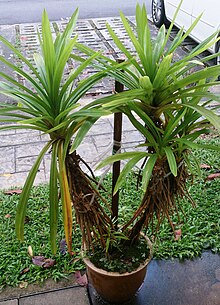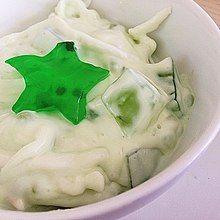Pandanus amaryllifolius
| Pandanus amaryllifolius | |
|---|---|

| |
| Scientific classification | |
| Kingdom: | Plantae |
| Clade: | Tracheophytes |
| Clade: | Angiosperms |
| Clade: | Monocots |
| Order: | Pandanales |
| Family: | Pandanaceae |
| Genus: | Pandanus |
| Species: | P. amaryllifolius
|
| Binomial name | |
| Pandanus amaryllifolius | |
| Synonyms[1] | |
| |
Pandanus amaryllifolius is a tropical plant in the Pandanus (screwpine) genus, which is commonly known as pandan (/ˈpændən/). It has fragrant leaves which are used widely for flavouring in the cuisines of Southeast Asia and South Asia.
Occurrence and habitat[]
Pandanus amaryllifolius is a true cultigen, and is believed to have been domesticated in ancient times. It is sterile and can only reproduce vegetatively through suckers or cuttings. It was first described from specimens from the Maluku Islands, and the rare presence of male flowers in these specimens may indicate that it is the origin of the species. However, as no other wild specimens have been found, this is still conjecture. The plant is grown widely throughout Southeast Asia. It has also been introduced to South Asia via Malaysia and Indonesia, where they are grown extensively, though South Asian populations have low genetic diversity.[2][3][4]
Botanical features[]
The characteristic aroma of pandan is caused by the aroma compound 2-acetyl-1-pyrroline, found in the lower epidermal papillae;[5] the compound gives white bread, jasmine rice, and basmati rice (as well as bread flowers Vallaris glabra) their typical smell.[6] Though the plant is unknown in the wild, it is widely cultivated. It is an upright, green plant with fan-shaped sprays of long, narrow, blade-like leaves and woody aerial roots. The plant is sterile, with flowers only growing very rarely, and is propagated by cuttings.[7][8]
Use[]
Culinary[]


In Singapore, Malaysia, Indonesia and the Philippines, it is commonly called pandan or pandan wangi (fragrant pandan). The green juice acquired from its leaf is used extensively in Malaysian cuisine and Indonesian cuisine as green food colouring and flavouring agents that gave pleasant aroma for kue, a tapioca, flour or glutinous rice-based traditional cakes; including klepon, kue putu, dadar gulung, lapis legit, pandan cake, buko pandan salad, and buko pandan cake. The tied knot of bruised pandan leaf is also added into fragrant coconut rice to enhance the aroma.[9]
In Sri Lanka, it is called rampé and it is grown almost in every household. Most of the Sri Lankan dishes use these leaves for aroma along with curry leaves. In India it is called annapurna leaves; In Odisha annapurna leaves are used to lend aroma to rice and pithas, in Bangladesh, it is called pulao pata (পোলাও পাতা); and in the Maldives, it is called ran’baa along with the other variety of pandan there (Pandanus fascicularis), and is used to enhance the flavor of pulao, biryani, and sweet coconut rice pudding, or payesh if basmati rice is not used. It acts as a cheap substitute for basmati fragrance, as one can use normal, nonfragrant rice and with pandan the dish tastes and smells like basmati is used. The leaves are used either fresh or dried, and are commercially available in frozen form in Asian grocery stores of nations where the plant does not grow. They have a nutty, botanical fragrance that is used as a flavor enhancer in many Asian cuisines, especially in rice dishes, desserts, and cakes.[10]
The leaves are sometimes steeped in coconut milk, which is then added to the dish. They may be tied in a bunch and cooked with the food. They may be woven into a basket which is used as a pot for cooking rice. Pandan chicken, (Thai: ไก่ห่อใบเตย, kai ho bai toei), is a dish of chicken parts wrapped in pandan leaves and fried. The leaves are also used as a flavoring for desserts such as pandan cake and sweet beverages. Filipino cuisine uses pandan as a flavoring in some coconut milk-based dishes as well as desserts like buko pandan.[11] It is also used widely in rice-based pastries such as suman and numerous sweet drinks and desserts.[12]
Pandan leaves and their extract have also been used as a food preservative due to their antibacterial and antifungal properties (particularly against mold).[13]
Bottled pandan extract is available in shops, and often contains green food coloring.
Fragrance and traditional medicine[]
The leaves are used in the perfume industry and traditional medicine.[14] P. amaryllifolius essence may substitute for vanilla essence.[15]
Studies have established repellent activity of P. amaryllifolius against American cockroaches (Periplaneta americana L.).[16]
Air freshener[]
The leaves possess a pleasant aroma and can be used as natural air fresheners.[17] In Thailand, cab drivers sometimes use pandan for this purpose.[18]
See also[]
References[]
- ^ "The Plant List: A Working List of All Plant Species". Retrieved 29 March 2015.
- ^ "Pandanus amaryllifolius – The only Pandanus with fragrant leaves". Tropical Biodiversity. 12 January 2013. Retrieved 30 January 2020.
- ^ Wakte, Kantilal V.; Nadaf, Altafhusain B; Thengane, Ratnakar J.; Jawali, Narendra (2009). "Pandanus amaryllifolius Roxb. cultivated as a spice in coastal regions of India". Genetic Resources and Crop Evolution. 56 (5): 735–740. doi:10.1007/s10722-009-9431-5. S2CID 11958062.
- ^ Stone, BC (1978). "Studies in Malesian Pandanaceae XVII. On the taxonomy of 'Pandan Wangi' — a Pandanus cultivar with scented leaves". Econ Bot. 32 (3): 285–293. doi:10.1007/BF02864702. S2CID 10919001.
- ^ Wakte, Kantilal V.; Nadaf, Altafhusain B.; Thengane, Ratnakar J.; Jawali, Narendra (2009). "Pandanus amaryllifolius Roxb. cultivated as a spice in coastal regions of India". Genetic Resources and Crop Evolution. 56 (5): 735–740. doi:10.1007/s10722-009-9431-5. ISSN 0925-9864. S2CID 11958062.
- ^ Wongpornchai, S.; Sriseadka, T. & Choonvisase, S. (2003). "Identification and quantitation of the rice aroma compound, 2-acetyl-1-pyrroline, in bread flowers (Vallaris glabra Ktze)". J. Agric. Food Chem. 51 (2): 457–462. doi:10.1021/jf025856x. PMID 12517110.
- ^ Barbano, Paul (29 January 2020). "To mimic its tropical home, give Pandan Grass lots of warmth and humidity". Cape Gazette. Retrieved 20 April 2021.
{{cite web}}: CS1 maint: url-status (link) - ^ "Home Guides: How to Plant Pandan". SF Gate. 9 July 2020. Retrieved 20 April 2021.
{{cite web}}: CS1 maint: url-status (link) - ^ "Pandan Leaf". The Epicentre. Retrieved 20 May 2020.
- ^ Sukphisit, Suthon (9 December 2018). "Reading the leaves". Bangkok Post. Retrieved 9 December 2018.
- ^ "Buko Pandan Salad Recipe". Pinoy Recipe At Iba Pa. Retrieved 4 June 2011.
- ^ IJsselstein. "Lyn's Recipes Corner". Buko Pandan Salad. Jeroen Hellingman. Archived from the original on 26 October 2011. Retrieved 18 October 2011.
- ^ Aini, Resmi; Mardiyaningsih, Ana (April 2009). "Pandan leaves extract (Pandanus amaryllifolius Roxb) as a food preservative". Indonesian Journal of Medicine and Health. 7 (4): 166–173. doi:10.20885/JKKI.Vol7.Iss4.art8 – via ResearchGate.
- ^ Keller J (2001) Pandanaceae. In: Hanelt P, Institute of Plant Genetics and Crop Plant Research (eds) Mansfeld’s encyclopedia of agricultural and horticultural crops, vol 5. Springer, Berlin, pp 2816–2824
- ^ Wyk BEV (2005) Food plants of the world: identification, culinary uses and nutritional value. Times Editions–Marshall Cavendish, Singapore, p 275
- ^ Ahmad, FBH; Mackeen, MM; Ali, AM; Mashirun, SR; Yaacob, MM (1995). "Repellency of essential oils against the domiciliary cockroach, Periplaneta americana L.". Insect Sci Appl. 16 (3–4): 391–393. doi:10.1017/s174275840001746x. S2CID 85986166.
- ^ Simmons, Holley. "This tropical plant gives foods a nutty flavor — and surprising color". The Washington Post. Archived from the original on 8 January 2019. Retrieved 8 January 2019.
- ^ "All You Need to Know About Pandan". Michelin Guide. Michelin. Archived from the original on 8 January 2019. Retrieved 8 January 2019.
Further reading[]
- Li J. and Ho S.H. (2003). Pandan leaves (Pandanus amaryllifolius Roxb.) as a Natural Cockroach Repellent. Proceedings of the 9th National Undergraduate Research Opportunities Programme (2003-09-13).
- Van Wyk, Ben-Erik (2005). Food Plants of the World. Portland, Oregon: Timber Press, Inc. ISBN 0-88192-743-0
External links[]
| Wikimedia Commons has media related to Pandanus amaryllifolius. |
- Pandanus
- Spices
- Asian cuisine
- Taxa named by William Roxburgh
